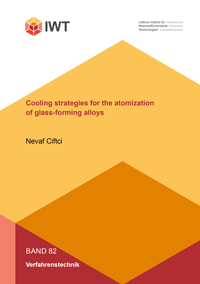
Shop : Details
Shop
Details
48,80 €ISBN 978-3-8440-7462-8Paperback156 Seiten59 Abbildungen230 g21 x 14,8 cmEnglischDissertation
Juli 2020
Nevaf Ciftci
Cooling strategies for the atomization of glass-forming alloys
Metallic glasses or bulk metallic glasses are a new class of materials. These amorphous metals have a disordered structure, resulting in outstanding properties when compared to crystalline materials such as high hardness, strength, elasticity, good wear and corrosion resistance, and superior soft magnetic properties. The properties of metallic glasses depend on alloy composition and cooling conditions during solidification. The liquid must be cooled rapidly to avoid crystallization, forcing the melt to retain its liquid atomic structure. The required cooling rates to obtain an amorphous solid are limited by time-dependent heat conduction, restricting product dimensions. Geometric limitations can be overcome by powder synthesis and consolidation to introduce metallic glasses to the commercial market. Gas atomization is a promising technique in the commercial production of metallic glasses, as amorphous particles can be produced due to the high surface-to-volume ratio through conduction and radiation.
The aim of this PhD thesis was the development of novel cooling strategies for the atomization of glass-forming alloys to increase cooling rates during droplet solidification. The focus was on the atomization of soft ferromagnetic glass-forming alloys with commercial purity. These alloys are difficult to atomize into an amorphous state due to cooling rate limitations and their low glass-forming ability. For this purpose, it was necessary to extend the common process window in gas atomization. This resulted in amorphous particles that normally tend to crystallize during droplet solidification. With the development of novel cooling strategies, new process windows have been made available that are typically inaccessible in conventional gas atomization. Four cooling strategies were developed for the atomization of glass-forming alloys: (i) increasing the melt superheat temperature, (ii) hot gas atomization, (iii) spray cone cooling, and (iv) liquid quenching. The developed cooling strategies were used to decrease potent nucleation sites in the melt, to produce smaller particles, and to increase the heat transfer coefficient.
The aim of this PhD thesis was the development of novel cooling strategies for the atomization of glass-forming alloys to increase cooling rates during droplet solidification. The focus was on the atomization of soft ferromagnetic glass-forming alloys with commercial purity. These alloys are difficult to atomize into an amorphous state due to cooling rate limitations and their low glass-forming ability. For this purpose, it was necessary to extend the common process window in gas atomization. This resulted in amorphous particles that normally tend to crystallize during droplet solidification. With the development of novel cooling strategies, new process windows have been made available that are typically inaccessible in conventional gas atomization. Four cooling strategies were developed for the atomization of glass-forming alloys: (i) increasing the melt superheat temperature, (ii) hot gas atomization, (iii) spray cone cooling, and (iv) liquid quenching. The developed cooling strategies were used to decrease potent nucleation sites in the melt, to produce smaller particles, and to increase the heat transfer coefficient.
Schlagwörter: Metallic glass; Gas atomization; Amorphous powders; Rapidsolidification; Cooling rate; Powder consolidation; Hydrogen; Magnetic properties
Forschungsberichte aus dem Leibniz-Institut für Werkstofforientierte Technologien
Herausgegeben von Prof. Dr.-Ing. habil. Ekkard Brinksmeier, Bremen
Band 82
Verfügbare Online-Dokumente zu diesem Titel
Sie benötigen den Adobe Reader, um diese Dateien ansehen zu können. Hier erhalten Sie eine kleine Hilfe und Informationen, zum Download der PDF-Dateien.
Bitte beachten Sie, dass die Online-Dokumente nicht ausdruckbar und nicht editierbar sind.
Bitte beachten Sie auch weitere Informationen unter: Hilfe und Informationen.
Bitte beachten Sie auch weitere Informationen unter: Hilfe und Informationen.
| Dokument |  | Gesamtdokument | ||
| Dateiart |  | |||
| Kosten |  | 36,60 € | ||
| Aktion |  | Zahlungspflichtig kaufen und anzeigen der Datei | ||
| Aktion |  | Zahlungspflichtig kaufen und download der Datei | ||
| Dokument |  | Inhaltsverzeichnis | ||
| Dateiart |  | |||
| Kosten |  | frei | ||
| Aktion |  | Anzeigen der Datei | ||
| Aktion |  | Download der Datei | ||
Benutzereinstellungen für registrierte Online-Kunden (Online-Dokumente)
Sie können hier Ihre Adressdaten ändern sowie bereits georderte Dokumente erneut aufrufen.
Benutzer
Nicht angemeldet
Export bibliographischer Daten
Shaker Verlag GmbHAm Langen Graben 15a52353 Düren
Mo. - Do. 8:00 Uhr bis 16:00 UhrFr. 8:00 Uhr bis 15:00 Uhr
Kontaktieren Sie uns. Wir helfen Ihnen gerne weiter.



